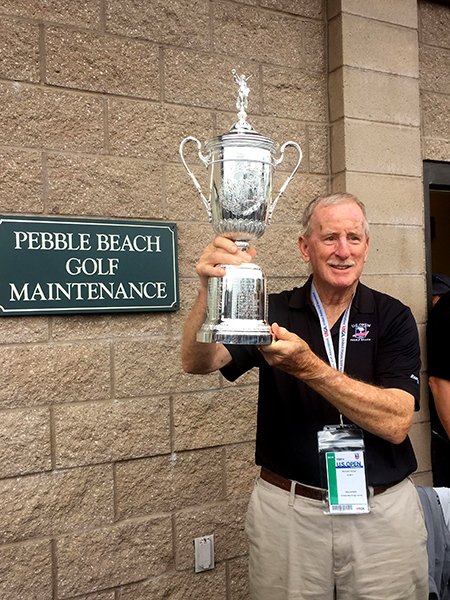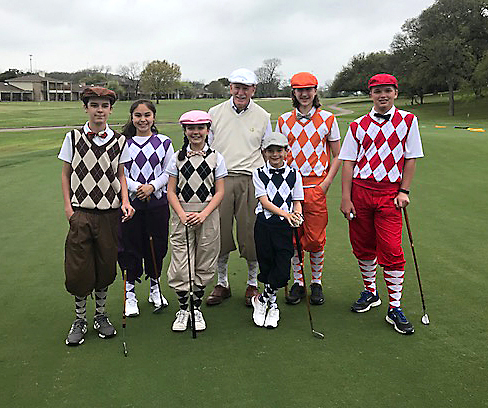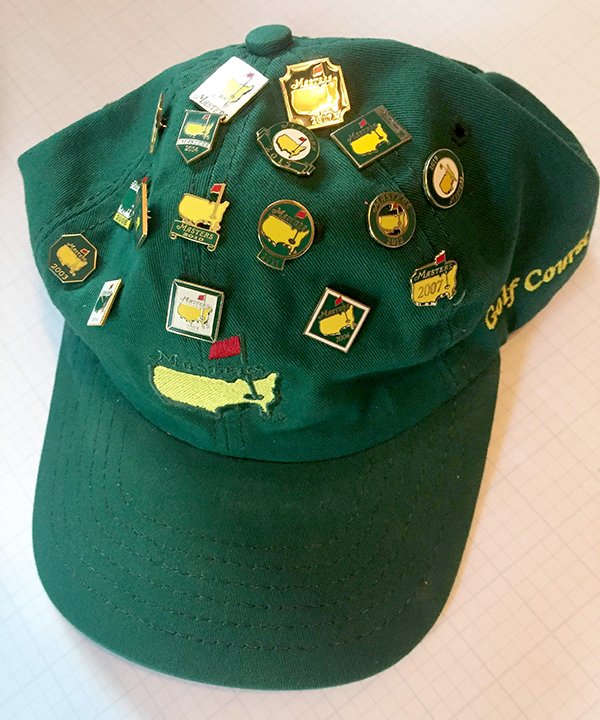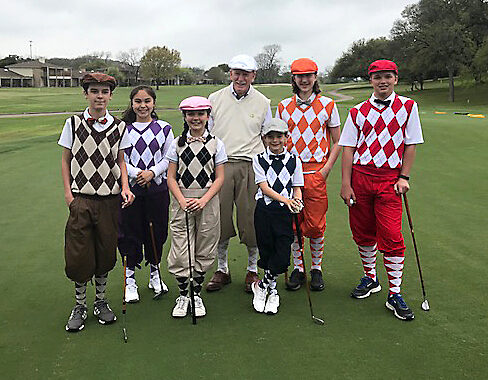Pete League

February 2021
By Sally J. Sportsman
We all know golf to be a game of honor and integrity, rich in history and tradition, brimming with fascinating stories and personalities over hundreds of years. It’s also true that devoted golfers tend to give back to the game and their communities in ways great and small. Pete League, a GHS member since 2006, stands out as one such devoted golfer. His efforts on behalf of others are exceptional and significant. A resident of Austin, Texas, he has traveled the world through his career and through golf. The friends and memories he’s made along the way are special. So too are the relationships he’s developed in the service of others.
The charitable work made possible by funds raised at the Onion Creek Hickory Classic exemplifies how League’s stewardship makes a lasting difference. His contributions to golf and his community service speak to the power of the game to exert a positive influence on the lives of others, including the neediest among us.
Where were you born, and where did you spend your childhood? Born and raised in Atlantic City, N.J., on Oct. 24, 1937. The beach and Boardwalk were my playground. I was the second-to-youngest of eight children and my parents were both elite amateur swimmers. My father supported his family as an Atlantic City fireman and he worked two or three jobs as long as I can remember. When I was 12 years old (1949), I learned that I could make some cash by carrying golf bags at Atlantic City Country Club in Northfield, N.J.
What is your educational background? Holy Spirit High School 1955. Before entering college, I worked in a large, 800-seat seafood restaurant, doing everything but cook and bus dishes. I spent two years in the U. S. Navy aboard a destroyer, working in the ship’s office. I left the Navy as a Yeoman Second Class. I was fortunate to have visited 19 countries during those two years. After a second stint at the same seafood restaurant, I accepted a job with RCA in Thule, Greenland, working on the Ballistic Missile Early Warning System (BMEWS) Project. While in Thule, I earned 15 college credit hours from the University of Maryland and that got me into the University of San Francisco, from which I graduated in 1966 with a BS in Industrial Relations.
What is or has been your profession, and what are some of your professional accomplishments? Campbell Soup Company in Sacramento, Calif., hired me as a production supervisor, but I really wanted to work on personnel and industrial relations issues and in 1967, I began work with Shell Oil Company at its research laboratory in Emeryville, Calif. I took an early retirement package from Shell in 1992 after assignments at multiple Shell locations around the United States. I developed expertise in staff planning, drug and alcohol abuse, sexual abuse and corporate recruitment issues. Following my Shell retirement, I accepted opportunities to establish new MBA Career Centers and MBA Alumni Relations programs at George Mason University (Fairfax, Va.) and the Monterey Institute of International Studies (Monterey, Calif.). During the mid-to-late 1990s, I co-chaired a committee of the MBA Career Services Council, which developed the Standards for Reporting MBA Employment Statistics. I consider having those standards accepted by major news magazines as one of my most meaningful accomplishments.
How were you first introduced to golf? When and why did the game become important to you? Via the caddie yard. I loved the game from the start.
What are some of your philanthropic interests? Homeless issues. In Austin, Texas, Mobile Loaves & Fishes began with one food truck in 1998. Today, ML&F serves over 1,000 homeless persons 365 days a year with 15 food trucks. ML&F also established Community First! Village, a 50-plus acre master-planned village which provides (so far) housing for over 200 formerly homeless persons. When completed, about 500 persons will reside within Community First! Village. The Onion Creek Hickory Classic, so far, has contributed over $10,000 to ML&F. I work several shifts each month as a ML&F food truck volunteer and I also manage an emergency cold weather shelter at Austin’s St. Ignatius Parish. We can accommodate up to 100 homeless men when the temperature dips to 32 F or below. We provide a hot meal, a warm place to sleep with a fresh blanket and sleeping pad, and breakfast and some take-away items in the morning.
What is it about playing hickory golf that you find intriguing and satisfying? It is a constant reminder of the fantastic heritage of our game. And… no one laughs at me when I mis-hit a shot.
The Onion Creek Hickory Classic has acquired quite a following. How has it grown over time? The tournament began as a small, one-day, outing initiated by Texas golf legend Johnny Henry in 1992 in the Dallas area. It migrated to Houston for a few years, and in 2004, Max Hill brought the tournament to Austin’s Onion Creek Club. Max also initiated the match-play component. I met Max in 2006 when I joined the Golf Collectors Society and I began assisting him with the tournament. When I took the baton in 2013, Onion Creek member Virgil Swift began his very nice financial support. A couple of years ago, we had 80 hickory players from 13 states and Canada. But the volunteers from the Onion Creek membership have a lot to do with the good feeling the tournament generates. Additionally, we try to have outstanding guest speakers at our awards dinner. Kathy Whitworth, for example, drove to Austin from the Dallas area a couple of years ago. Robin Burke of Champions Golf Club and Charlie Epps, Angel Cabrera’s coach, both made the trek from Houston. And we have had local guest speakers of note. (Joe Black, a past PGA of America president and Kevin Robbins, a two-time Herbert Warren Wind Award winner for his books on Harvey Penick and Payne Stewart, have been speakers at Onion Creek).

You have volunteered extensively in golf, and continue to do so. What are some of the highlights of your volunteering experience? Establishing friendships around the country would be the highlight. I consider the entire maintenance team at Pebble Beach to be my friends. Micah Woods, owner of the Asian Turfgrass Center in Thailand, and I have shared accommodations for about 15 years during the Masters Tournament. Knowing Vollie Carr of Textron before he passed away several years ago was a privilege. And there is Jack Holt at Pebble Beach, who retired in 2019 after the U. S. Open. Jack was at Pebble Beach for many years (and his father was a long-time Pebble Beach caddie). I liken him to a Chief Boatswain’s Mate on a Navy destroyer. The chief sees captains come and go, but he keeps the ship running and looking great. Jack has seen superintendents come and go, but he keeps the golf course looking great year after year. Special friends are Richard Hagy, a VP at Aspen Corporation, and Ike Stokes of Augusta National Golf Club. Richard knows golf course renovation and restoration! Ike has been at ANGC for about 50 years and he is a person whom everyone loves and respects. The three of us have a little ritual after our morning assignments are completed: breakfast at one of the concession tents. Of course, another highlight was working all four majors in 2010 – a “Pete Slam” according to my friend John Montanez of Pacific Grove, Calif. And there is Merion, a historic course where I worked for Matt Shafer during a Walker Cup and a U. S. Open.
What has the game meant to you through the years? The reinforcement of a solid value system, where honesty and integrity play as large a role as skill.
What is one of your favorite golf memories? I don’t have just one favorite, but… watching Hogan hit balls for about 45 minutes (it was just Hogan, his caddie and me, literally!) at Atlantic City Country Club in 1954. I sat on the grass about five yards from him. He looked at me, I looked at him; not a word was said but I definitely got the message: “Not a word, kid!” My sole ace several years ago at Onion Creek Club. Carrying Bo Winniger’s bag at ACCC in the early 1950s. My first Masters in 1987 (Mize). Playing nine rounds in six days during my first trip to Scotland in 1990.
How did you learn about the GHS and when did you join? I saw Bill Reed at Onion Creek. He was kind enough to let me take a hickory club out of his bag and waggle it. I think I joined the next day. It was about 2006.
What is an aspect of golf history that you find fascinating? Everything in the outstanding book, Tom Morris of St. Andrews, The Colossus of Golf, 1821 – 1908, by David Malcolm and Peter Crabtree. BEST. GOLF. BOOK. EVER.
What kinds of golf artifacts and collectibles interest you? Everything. But putters and books specifically. I don’t collect balls. With all respect to golf ball collectors, I think I might go batty collecting balls. I don’t consider myself a collector. I am just an imposter when it comes to collecting.
Why do you enjoy being a GHS member? The relationships.


